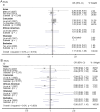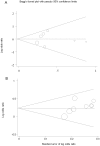Association of OPA1 polymorphisms with NTG and HTG: a meta-analysis
- PMID: 22879959
- PMCID: PMC3411762
- DOI: 10.1371/journal.pone.0042387
Association of OPA1 polymorphisms with NTG and HTG: a meta-analysis
Abstract
Background: Genetic polymorphisms of the Optic atrophy 1 gene have been implicated in altering the risk of primary open angle glaucoma (POAG), especially the susceptibility to normal tension glaucoma (NTG), but the results remain controversial.
Methods: Multiple electronic databases (up to January 20, 2012) were searched independently by two investigators. A meta-analysis was performed on the association between Optic atrophy 1 polymorphisms (rs 166850 and rs 10451941) and normal tension glaucoma (NTG)/high tension glaucoma (HTG). Summary odds ratios (ORs) and 95% confidence intervals (CI) were estimated.
Results: Seven studies of 713 cases and 964 controls for NTG and five studies of 1200 cases and 971 controls for HTG on IVS8+4C>T (rs 166850) and IVS8+32T>C (rs10451941) were identified. There were significant associations between the OPA1 rs10451941polymorphism and NTG susceptibility for all genetic models(C vs. T OR = 1.26, 95% CI 1.09-1.47, p = 0.002; CC vs. TT: OR = 1.52, 95% CI 1.04-2.20, p = 0.029; CC vs. CT+TT: OR = 1.64, 95% CI 1.16-2.33, p = 0.005; CC+CT vs. TT: OR = 1.21, 95% CI 1.02-1.44, p = 0.032). However, no evidence of associations was detected between the OPA1 IVS8+32C>T polymorphism and POAG susceptibility to HTG. Similarly, clear associations between the rs 166850 variant and NTG were observed in allelic and dominant models (T vs. C OR = 1.52, 95% CI 1.16-1.99, p = 0.002; TT+TC vs. CC OR = 1.50, 95% CI 1.13-2.01, p = 0.006) but not to HTG. In subgroup analyses by ethnicity, we detected an association between both OPA1 polymorphisms and risk for NTG in Caucasians but not in Asians. By contrast, no significant findings were noted between OPA1 variants for HTG, either in Caucasians or in Asians.
Conclusions: Both the IVS8+4C>T and IVS8+32T>C variants may affect individual susceptibility to NTG. Moreover, stratified analyses for NTG detecting the effects of both OPA1 polymorphisms seemed to vary with ethnicity. Further investigations are needed to validate the association.
Conflict of interest statement
Figures






Similar articles
-
Investigation of the association between OPA1 polymorphisms and normal-tension glaucoma in Korea.J Glaucoma. 2004 Dec;13(6):492-5. doi: 10.1097/01.ijg.0000137870.25779.40. J Glaucoma. 2004. PMID: 15534475
-
OPA1 increases the risk of normal but not high tension glaucoma.J Med Genet. 2010 Feb;47(2):120-5. doi: 10.1136/jmg.2009.067512. Epub 2009 Jul 5. J Med Genet. 2010. PMID: 19581274 Free PMC article.
-
Associations between OPA1, MFN1, and MFN2 polymorphisms and primary open angle glaucoma in Polish participants of European ancestry.Ophthalmic Genet. 2022 Feb;43(1):42-47. doi: 10.1080/13816810.2021.1970197. Epub 2021 Aug 23. Ophthalmic Genet. 2022. PMID: 34425738
-
Association of Gene Polymorphisms with Normal Tension Glaucoma: A Systematic Review and Meta-Analysis.Genes (Basel). 2024 Apr 14;15(4):491. doi: 10.3390/genes15040491. Genes (Basel). 2024. PMID: 38674425 Free PMC article.
-
The association between IL-1 family gene polymorphisms and colorectal cancer: A meta-analysis.Gene. 2021 Feb 15;769:145187. doi: 10.1016/j.gene.2020.145187. Epub 2020 Sep 28. Gene. 2021. PMID: 32998046 Review.
Cited by
-
Genetics of primary open angle glaucoma.Jpn J Ophthalmol. 2014 Jan;58(1):1-15. doi: 10.1007/s10384-013-0286-0. Epub 2013 Nov 21. Jpn J Ophthalmol. 2014. PMID: 24258795 Review.
-
A Review of Mitochondrial Optic Neuropathies: From Inherited to Acquired Forms.J Optom. 2017 Oct-Dec;10(4):205-214. doi: 10.1016/j.optom.2016.09.003. Epub 2016 Dec 28. J Optom. 2017. PMID: 28040497 Free PMC article. Review.
-
Asian Race and Primary Open-Angle Glaucoma: Where Do We Stand?J Clin Med. 2022 Apr 28;11(9):2486. doi: 10.3390/jcm11092486. J Clin Med. 2022. PMID: 35566612 Free PMC article. Review.
-
Ethnicity-related differences in mitochondrial regulation by insulin stimulation in diabetes.J Cell Physiol. 2024 Aug;239(8):e31317. doi: 10.1002/jcp.31317. Epub 2024 May 22. J Cell Physiol. 2024. PMID: 38775168 Free PMC article. Review.
-
BAX to basics: How the BCL2 gene family controls the death of retinal ganglion cells.Prog Retin Eye Res. 2017 Mar;57:1-25. doi: 10.1016/j.preteyeres.2017.01.002. Epub 2017 Jan 4. Prog Retin Eye Res. 2017. PMID: 28064040 Free PMC article. Review.
References
-
- Coleman AL, Brigatti L (2001) The glaucomas. Minerva Med 92: 365–379. - PubMed
-
- Cedrone C, Mancino R, Cerulli A, Cesareo M, Nucci C (2008) Epidemiology of primary glaucoma: prevalence, incidence, and blinding effects. Prog Brain Res 173: 3–14. - PubMed
-
- Wen W, Sun XH (2010) Primary glaucoma and psychological characteristics]. Zhonghua Yan Ke Za Zhi 46: 566–571. - PubMed
-
- Kim E, Varma R (2010) Glaucoma in Latinos/Hispanics. Curr Opin Ophthalmol 21: 100–105. - PubMed
-
- Foster PJ (2002) The epidemiology of primary angle closure and associated glaucomatous optic neuropathy. Semin Ophthalmol 17: 50–58. - PubMed
Publication types
MeSH terms
Substances
LinkOut - more resources
Full Text Sources
Other Literature Sources
Medical

